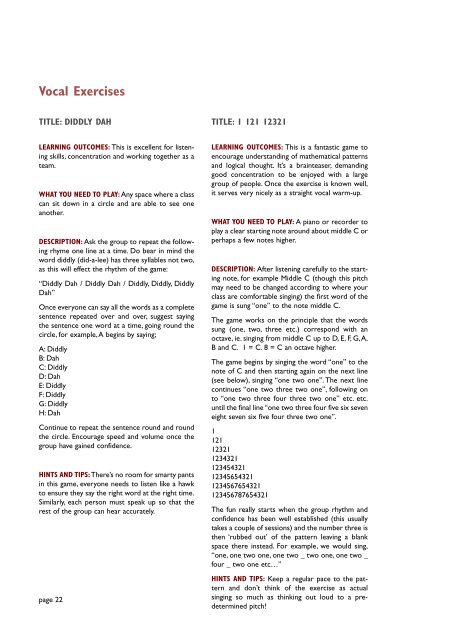USING DRAMA AS A TEACHING TOOL - Reeling & Writhing
USING DRAMA AS A TEACHING TOOL - Reeling & Writhing
USING DRAMA AS A TEACHING TOOL - Reeling & Writhing
You also want an ePaper? Increase the reach of your titles
YUMPU automatically turns print PDFs into web optimized ePapers that Google loves.
Vocal Exercises<br />
TITLE: DIDDLY DAH TITLE: 1 121 12321<br />
LEARNING OUTCOMES: This is excellent for listening<br />
skills, concentration and working together as a<br />
team.<br />
WHAT YOU NEED TO PLAY: Any space where a class<br />
can sit down in a circle and are able to see one<br />
another.<br />
DESCRIPTION: Ask the group to repeat the following<br />
rhyme one line at a time. Do bear in mind the<br />
word diddly (did-a-lee) has three syllables not two,<br />
as this will effect the rhythm of the game:<br />
“Diddly Dah / Diddly Dah / Diddly, Diddly, Diddly<br />
Dah”<br />
Once everyone can say all the words as a complete<br />
sentence repeated over and over, suggest saying<br />
the sentence one word at a time, going round the<br />
circle, for example,A begins by saying;<br />
A: Diddly<br />
B: Dah<br />
C: Diddly<br />
D: Dah<br />
E: Diddly<br />
F: Diddly<br />
G: Diddly<br />
H: Dah<br />
Continue to repeat the sentence round and round<br />
the circle. Encourage speed and volume once the<br />
group have gained confidence.<br />
HINTS AND TIPS:There’s no room for smarty pants<br />
in this game, everyone needs to listen like a hawk<br />
to ensure they say the right word at the right time.<br />
Similarly, each person must speak up so that the<br />
rest of the group can hear accurately.<br />
page 22<br />
LEARNING OUTCOMES: This is a fantastic game to<br />
encourage understanding of mathematical patterns<br />
and logical thought. It’s a brainteaser, demanding<br />
good concentration to be enjoyed with a large<br />
group of people. Once the exercise is known well,<br />
it serves very nicely as a straight vocal warm-up.<br />
WHAT YOU NEED TO PLAY: A piano or recorder to<br />
play a clear starting note around about middle C or<br />
perhaps a few notes higher.<br />
DESCRIPTION: After listening carefully to the starting<br />
note, for example Middle C (though this pitch<br />
may need to be changed according to where your<br />
class are comfortable singing) the first word of the<br />
game is sung “one” to the note middle C.<br />
The game works on the principle that the words<br />
sung (one, two, three etc.) correspond with an<br />
octave, ie. singing from middle C up to D, E, F, G,A,<br />
B and C. 1 = C. 8 = C an octave higher.<br />
The game begins by singing the word “one” to the<br />
note of C and then starting again on the next line<br />
(see below), singing “one two one”. The next line<br />
continues “one two three two one”, following on<br />
to “one two three four three two one” etc. etc.<br />
until the final line “one two three four five six seven<br />
eight seven six five four three two one”.<br />
1<br />
121<br />
12321<br />
1234321<br />
123454321<br />
12345654321<br />
1234567654321<br />
123456787654321<br />
The fun really starts when the group rhythm and<br />
confidence has been well established (this usually<br />
takes a couple of sessions) and the number three is<br />
then ‘rubbed out’ of the pattern leaving a blank<br />
space there instead. For example, we would sing,<br />
“one, one two one, one two _ two one, one two _<br />
four _ two one etc…”<br />
HINTS AND TIPS: Keep a regular pace to the pattern<br />
and don’t think of the exercise as actual<br />
singing so much as thinking out loud to a predetermined<br />
pitch!


